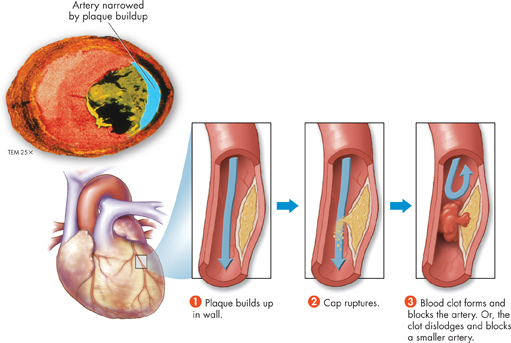Heart Disease Heart muscle requires a constant supply of oxygen. Yet the heart is supplied with blood by just two coronary arteries and their smaller branches. There are many types of heart disease, but the most common occur when blood flow through these vessels is obstructed.
One example is atherosclerosis, a condition in which fatty deposits called plaques build up in artery walls and eventually cause the arteries to stiffen. Over time, plaques often bulge into the center of a vessel and restrict blood flow to heart muscle. Chest pain, known as angina, can be a sign of restricted blood flow. Eventually, the heart can be weakened or damaged by oxygen deprivation, leading to a condition called heart failure.
BUILD Vocabulary
WORD ORIGINS Atherosclerosis comes from the Greek words athero (gruel or paste) and sclerosis (hardness). Atherosclerosis is hardening of the arteries that results from fatty deposits.
If the cap on a plaque ruptures, a blood clot may form that completely blocks an artery, as shown in Figure 33–11. A heart attack occurs as heart muscle cells become damaged and possibly die. Heart attacks can also damage the SA or AV nodes, which can affect the heart's ability to beat in a coordinated way. Arteries severely narrowed by atherosclerosis, the use of drugs such as cocaine, and cigarette smoking can also lead to a heart attack.
Heart attack symptoms include nausea; shortness of breath; chest pain; and pain in the neck, jaw, or left arm. People with these symptoms need immediate medical attention. Medication needs to be given quickly to increase blood flow and save heart muscle.

FIGURE 33–11 Atherosclerosis Most heart attacks occur when a plaque ruptures in a coronary artery and a clot forms. Clots can also form in large vessels in other parts of the body, break off, and block vessels in the heart that are narrowed by atherosclerosis. Predict What do you think would happen if a clot broke off from an artery and blocked a vessel in the brain?
dStroke The sudden death of brain cells when their blood supply is interrupted is called a stroke. Some strokes are caused by a blood clot that blocks a blood vessel in the brain. A stroke can also occur if a weak blood vessel breaks and causes bleeding in the brain. Symptoms of stroke include severe headache, numbness, dizziness, confusion, and trouble seeing or speaking. The results of a stroke vary, depending on which part of the brain it affects. Some strokes cause death. Other strokes may cause paralysis or loss of speech. Prompt medical treatment may lessen the severity of a stroke.
Table of Contents
- Formulas and Equations
- Applying Formulas and Equations
- Mean, Median, and Mode
- Estimation
- Using Measurements in Calculations
- Effects of Measurement Errors
- Accuracy
- Precision
- Comparing Accuracy and Precision
- Significant Figures
- Calculating With Significant Figures
- Scientific Notation
- Calculating With Scientific Notation
- Dimensional Analysis
- Applying Dimensional Analysis




